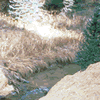
The NPS pollutant of greatest concern from forestry activities is sediment.
Descriptions of this land use category and its Management Measures are adapted from California’s NPS Encyclopedia. More Info

Perform advance planning for forest harvesting to minimize NPS runoff. Addresses the timing, location, and design of harvesting and road construction; site preparation; identification of sensitive or high-erosion risk areas; and the potential for cumulative water quality impacts. More Info
Establish and maintain a Streamside Management Area (SMA) along surface waters to safeguard vegetated buffer areas along surface waters to protect the water quality of adjacent streams. Addresses protecting against soil disturbance, reducing sediment and nutrient delivery to the waterbody, buffering against adverse changes in the waterbody’s temperature regime, and providing a sustainable source of large woody debris. More Info


Follow road construction and reconstruction plans, designs, and practices to protect surface waters from sediment and debris. Addresses following pre-harvest plan layouts and designs for road systems, incorporating adequate drainage structures, properly installing stream crossings, avoiding road construction in SMAs, removing debris from streams, and stabilizing areas of disturbed soil such as road fills. More Info
Manage roads to prevent sedimentation, minimize erosion, maintain stability, and reduce the risk that drainage structures and stream crossings will fail or become less effective. Addresses inspections and maintenance actions to prevent erosion of road surfaces and ensure the effectiveness of stream-crossing structures, and appropriate methods for closing roads that are no longer in use. More Info


Follow timber harvesting practices that protect water quality and soil productivity. Addresses skid trail location and drainage, management of debris and petroleum, and proper harvesting in SMAs. More Info
Minimize erosion and confine onsite any potential NPS pollution resulting from site preparation and regeneration of forest stands. Addresses keeping slash material out of drainageways, operating machinery on contours, timing of activities, and protecting ground cover in ephemeral drainage areas and SMAs. More Info


Follow prescribed fire practices for site preparation and wildfire control or suppression in a manner that reduces potential NPS pollution of surface waters. Prescribed fires that remove forest litter down to mineral soil on steep slopes or adjacent to streams are most likely to affect water quality. More Info
Reduce erosion and prevent sedimentation by rapid revegetation of areas disturbed by timber operations. Concentrate revegetation efforts initially on priority areas such as disturbed areas in Streamside Management Areas or the steepest areas of disturbance near drainages. More Info


Follow the proper application of chemicals and fertilizers in forestry management to reduce NPS pollution impacts due to the movement of forest chemicals offsite. Addresses applications by skilled workers according to label instructions, careful prescription of the type and amount of chemical to be applied, use of buffer areas for surface waters to prevent direct application or deposition, and spill contingency planning. More Info
Plan, operate, and manage forestry activities (including harvesting, road design and construction, site preparation and regeneration, and chemical management) to adequately protect the aquatic functions of forested wetlands. Forested wetlands provide beneficial ecosystem functions such as flood-flow alteration, sediment trapping, nutrient retention and removal, provision of important habitat for fish and wildlife, and provision of timber products. More Info


Conduct post-harvest monitoring, including both implementation monitoring and effectiveness monitoring. Implementation monitoring determines whether the operation was conducted according to specifications, and effectiveness monitoring (after at least one winter period) determines whether the specified operation minimized discharges. More Info
Implement educational programs on applicable forestry Management Measures and practices where needed to prevent adverse impacts to surface waters and groundwater from NPS pollution. Public education, outreach, and training programs should involve user groups and the community. More Info
